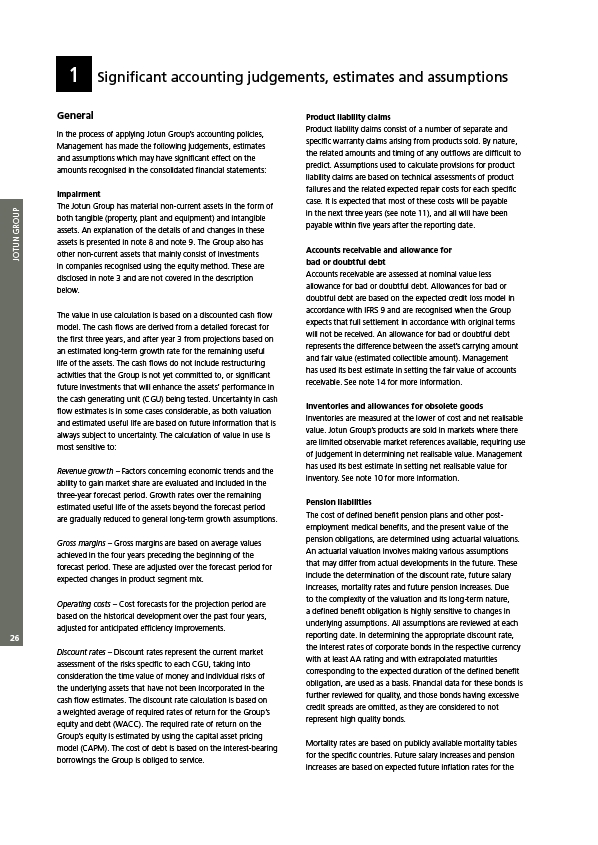
JOTUN GROUP
26
1 Significant accounting judgements, estimates and assumptions
General
In the process of applying Jotun Group’s accounting policies,
Management has made the following judgements, estimates
and assumptions which may have significant effect on the
amounts recognised in the consolidated financial statements:
Impairment
The Jotun Group has material non-current assets in the form of
both tangible (property, plant and equipment) and intangible
assets. An explanation of the details of and changes in these
assets is presented in note 8 and note 9. The Group also has
other non-current assets that mainly consist of investments
in companies recognised using the equity method. These are
disclosed in note 3 and are not covered in the description
below.
The value in use calculation is based on a discounted cash flow
model. The cash flows are derived from a detailed forecast for
the first three years, and after year 3 from projections based on
an estimated long-term growth rate for the remaining useful
life of the assets. The cash flows do not include restructuring
activities that the Group is not yet committed to, or significant
future investments that will enhance the assets’ performance in
the cash generating unit (CGU) being tested. Uncertainty in cash
flow estimates is in some cases considerable, as both valuation
and estimated useful life are based on future information that is
always subject to uncertainty. The calculation of value in use is
most sensitive to:
Revenue growth – Factors concerning economic trends and the
ability to gain market share are evaluated and included in the
three-year forecast period. Growth rates over the remaining
estimated useful life of the assets beyond the forecast period
are gradually reduced to general long-term growth assumptions.
Gross margins – Gross margins are based on average values
achieved in the four years preceding the beginning of the
forecast period. These are adjusted over the forecast period for
expected changes in product segment mix.
Operating costs – Cost forecasts for the projection period are
based on the historical development over the past four years,
adjusted for anticipated efficiency improvements.
Discount rates – Discount rates represent the current market
assessment of the risks specific to each CGU, taking into
consideration the time value of money and individual risks of
the underlying assets that have not been incorporated in the
cash flow estimates. The discount rate calculation is based on
a weighted average of required rates of return for the Group’s
equity and debt (WACC). The required rate of return on the
Group’s equity is estimated by using the capital asset pricing
model (CAPM). The cost of debt is based on the interest-bearing
borrowings the Group is obliged to service.
Product liability claims
Product liability claims consist of a number of separate and
specific warranty claims arising from products sold. By nature,
the related amounts and timing of any outflows are difficult to
predict. Assumptions used to calculate provisions for product
liability claims are based on technical assessments of product
failures and the related expected repair costs for each specific
case. It is expected that most of these costs will be payable
in the next three years (see note 11), and all will have been
payable within five years after the reporting date.
Accounts receivable and allowance for
bad or doubtful debt
Accounts receivable are assessed at nominal value less
allowance for bad or doubtful debt. Allowances for bad or
doubtful debt are based on the expected credit loss model in
accordance with IFRS 9 and are recognised when the Group
expects that full settlement in accordance with original terms
will not be received. An allowance for bad or doubtful debt
represents the difference between the asset’s carrying amount
and fair value (estimated collectible amount). Management
has used its best estimate in setting the fair value of accounts
receivable. See note 14 for more information.
Inventories and allowances for obsolete goods
Inventories are measured at the lower of cost and net realisable
value. Jotun Group’s products are sold in markets where there
are limited observable market references available, requiring use
of judgement in determining net realisable value. Management
has used its best estimate in setting net realisable value for
inventory. See note 10 for more information.
Pension liabilities
The cost of defined benefit pension plans and other postemployment
medical benefits, and the present value of the
pension obligations, are determined using actuarial valuations.
An actuarial valuation involves making various assumptions
that may differ from actual developments in the future. These
include the determination of the discount rate, future salary
increases, mortality rates and future pension increases. Due
to the complexity of the valuation and its long-term nature,
a defined benefit obligation is highly sensitive to changes in
underlying assumptions. All assumptions are reviewed at each
reporting date. In determining the appropriate discount rate,
the interest rates of corporate bonds in the respective currency
with at least AA rating and with extrapolated maturities
corresponding to the expected duration of the defined benefit
obligation, are used as a basis. Financial data for these bonds is
further reviewed for quality, and those bonds having excessive
credit spreads are omitted, as they are considered to not
represent high quality bonds.
Mortality rates are based on publicly available mortality tables
for the specific countries. Future salary increases and pension
increases are based on expected future inflation rates for the